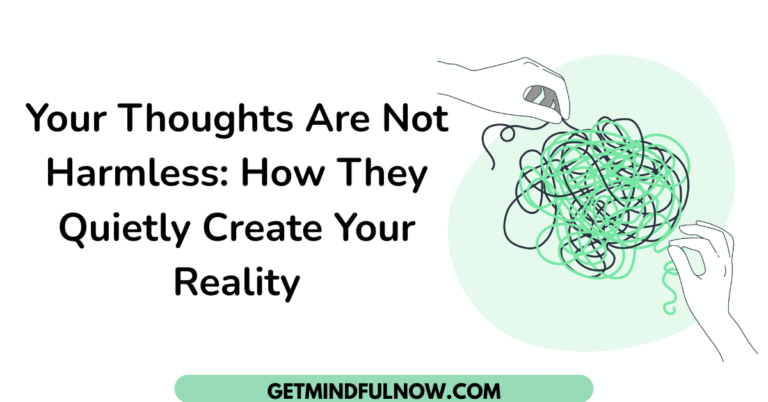Let’s not sugarcoat this: most people wake up every day and unconsciously live the same life they swore they wanted to change.
Same emotions. Same complaints. Same reactions.
And it’s not because they’re lazy or weak, it’s because they haven’t yet realized this truth:
Your thoughts are not harmless. They’re creative. They build your life in real time.
I’m not saying that thinking about money will drop a bag of cash at your door. That’s wishful thinking. What I am saying is that the way you think today will shape how you feel, how you show up, and how your life unfolds tomorrow.
This is not philosophy. It’s physics, biology, and neuroscience all working together. And once you get it, it’s impossible to keep living on autopilot.
You Think the Same Thoughts Every Day (And That’s the Problem)
Let’s start with the facts. Research shows that we think 60,000 to 70,000 thoughts per day. And guess what?
90% of those are the same as yesterday’s.
This means if you felt stuck, worried, or powerless yesterday… you’re probably repeating those same patterns today. Not because you want to. But because your brain is wired to prefer what’s familiar, even if it’s miserable.

That’s how thoughts turn into emotional addictions.
You start thinking a certain way. That thought triggers a feeling. That feeling affirms the thought. Now you’re stuck in a loop.
Thought: “I never get what I want.”
Feeling: Defeated
Action: Withdraw or procrastinate
Result: Nothing changes
Feedback: “See? I knew it.”
And the loop keeps going.
Your Brain Is Not Just a Thinking Machine—It’s a Prediction Engine
Here’s what science tells us: your brain isn’t just sitting around thinking random stuff. It’s predicting your life moment by moment, based on what it already knows.
Your brain uses your past experiences to guess what’s coming next. That’s called predictive coding, and it’s one of the brain’s superpowers, but also one of its traps.
So if you’ve been hurt, abandoned, overlooked, or disappointed, your brain stores that information and starts assuming the worst. Not because it hates you. But because it thinks it’s keeping you safe.
Now every time you try to step into something new, start a project, open up to someone, take a risk, your brain says:
“Let’s just repeat the past. That feels safer.”
And boom. You’re back to the same old emotions, actions, and results.
You Don’t Just Think Thoughts—You Feel Them
Here’s the part most people miss: your body doesn’t care what your goals are. It cares what chemicals you’re releasing.
And every thought you think, especially repeated ones, creates a chemical response.
- Think a stressful thought → release cortisol → feel tension
- Think a joyful thought → release dopamine or oxytocin → feel light
Over time, your body gets used to these chemicals. That’s why you can become addicted to worry, guilt, or even shame. Not because you enjoy them, but because they’re familiar.
Your body is literally like:
“Oh, I know this feeling. We do this every day at 8am!”
So even if your mind wants change, your body is living in the past. That’s why people self-sabotage. They’re not weak. Their body just hasn’t caught up with their vision.
Your Thoughts Send a Signal—And Your Body Becomes the Receiver
Let me put this in your language, the way I’d explain it to someone sitting across from me during a coaching session:
Your thoughts are like emails you send to your future self.
If you keep sending the same message—“I’m stuck,” “I’m not enough,” “Life is hard”—don’t be surprised when your life keeps delivering exactly that.
That’s not magic. That’s how energy works.
Every thought carries a frequency.
Every emotion reinforces it.
And your body responds to that loop until it becomes your personal reality.
I Didn’t Believe It Either—Until I Watched It Happen in My Own Life
Let me get real with you.
There was a time I used to think change had to come from the outside. A new job. A relationship. A big opportunity. Something out there that would finally fix everything in here.
But what actually changed me… was learning how to interrupt my old thinking.
I remember sitting alone, deeply anxious, repeating the same thoughts I’d had for years:
- “Nothing ever works out for me.”
- “I’m always the one who has to start over.”
- “People never really get me.”
And one day, I caught it. That thought. That loop.
And for the first time, I didn’t just let it run.
I asked myself: What if I’ve just been rehearsing these beliefs like an actor?
That was the beginning. That one crack in the loop opened a new path. One where I wasn’t trapped by the voice in my head—but able to train it into something new.
So… How Do You Change a Thought Loop?
This part matters. And it’s simpler than you think:
1. Notice the Thought
You can’t change what you’re not aware of. Start observing your thoughts like you’re watching a movie. No judgment. Just noticing.
“Oh, I just told myself I’m not ready. Again.”
2. Interrupt the Pattern
Say it out loud. “That’s not helping me.” Then ask: Is this a thought I want to keep practicing?
3. Introduce a New Thought (That You Can Believe)
Don’t jump from “I’m a mess” to “I’m perfect.” Your brain will reject it. Try something believable like:
“I’m learning how to handle this differently.”
4. Feel the New Emotion
Picture the outcome you want. Feel what it would be like if it were already true.
Let that emotion flood your body, even just for a minute. That’s how you break the cycle.

Final Thought: Your Reality Isn’t Fixed. It’s Memorized.
I’ll leave you with this:
Your life isn’t a reflection of your goals.
It’s a reflection of your mental rehearsals.
You’ve been practicing a certain version of you for years. But practice doesn’t make perfect, it makes permanent.
So the real question is:
What version of you are you still rehearsing?
And are you ready to start practicing something new?
Because once you change your thoughts,
You start changing your emotions.
Which changes your behavior.
Which rewires your brain.
Which changes your personality.
Which changes your personal reality.
That’s not woo. That’s science.
And it starts the moment you decide:
I’m done thinking like the old me.








